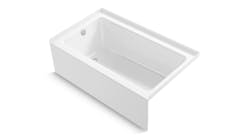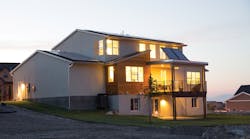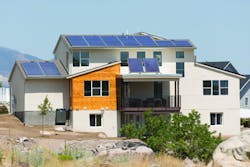Latest from Green
Sponsored
Garbett Homes, a builder based in Salt Lake City, and Vivint Inc., a home automation company based in Provo, Utah, have partnered to construct an affordable home that is so energy-efficient, it consumes as much energy as it produces. The Zero Home, built in Herriman, a suburb of Salt Lake City, reportedly is the first of its kind priced for average buyers, not the super-rich. Rated Energy Star 3.0, it also is the first home in Utah to receive the U.S. Department of Energy Challenge Home Certification.
According to Garbett, The Zero Home is the first net-zero, Climate Zone 5 production home built in the U.S. While net-zero, Climate Zone 5 projects have been attempted in the past, The Zero Home is the first smart home design that is highly replicable, affordable and scalable. Instead of costing $1 million, these homes can be purchased for $350,000.
The Zero Home features a home energy rating system (HERS) of zero. Reaching a zero rating means the home is completely self-sustaining. The building is still connected to the grid for backup, but the majority of the energy it uses is produced through solar and other renewable sources. In contrast, a typical resale home has an HERS rating of 130 and a standard new home has a rating of 10.
What is Climate Zone 5? The IECC climate zone map divides counties in the U.S. into eight temperature-oriented climate zones; generally, the higher the climate zone number, the colder the region. The Salt Lake City area is located in Climate Zone 5, according to the U.S. Department of Energy Building America Program. This zone has extreme temperature fluctuations—over 100ºF during summer to less than 20ºF during winter.
To achieve a zero HERS rating, the building has double-paned windows filled with argon gas, special frames and seals for the windows and doors, four types of insulation and solar panels to produce electricity. While the home is nearly airtight, it uses an air-exchange unit that recycles fresh air into the structure and heats or cools the incoming air. For hot water, the house uses solar-heated water tanks that can produce large quantities on-demand with little or no energy needed for warm-up.
ENERGY-EFFICIENT COMPONENTS
The structure’s energy-efficient highlights include:
Vivint Solar provides a 10.29-kilowatt solar photovoltaic energy system. The building also incorporates micro-inverter technology to provide maximum production for the home—even in less than optimal weather conditions.
Tight Building Envelope: Advanced framing techniques, sophisticated insulation, air sealing, tight ducts and air barriers work together to control air and moisture flow and keep The Zero Home’s utility bills as low as possible. By retaining its own heat, the house uses less energy.
Healthy Indoor Air: The Zero Home has received the EPA Indoor Air Plus Qualification. It also has an air change rate of less than one, which means that air cannot escape from the home.
Heating and Cooling: The Zero Home uses solar hot water and two 94% super-efficient, Noritz EchoTough, natural gas condensing tankless water heaters. It also features a 96% efficient natural gas back-up furnace with high-efficiency motors for the main blower as well as inducer motors.
Remote Climate Control: The building features Vivint’s programmable smart thermostat, which can be controlled remotely using a smartphone or tablet.
Energy Analytics: The structure monitors energy flow into and out of the home with real-time energy analytics. Residents know exactly how much energy they are consuming.
Home Automation: The Vivint system allows the homeowner to control the thermostat, view energy consumption and generation in real-time, lock or unlock doors, and turn off lights from a mobile phone or Internet-enabled device.
The Zero Home includes the following hardware:
Solar Power: 10.29-kilowatt solar photovoltaic energy system by Vivint.
Solar Hot Water: Velux 2x single-glazed flat plate collectors; Velux 65-gallon holding tank.
Air Source Heat Pump: XL20I Weathertron 9 HSPF (heating seasonal performance factor) rating (heating), 16.75 SEER rating (cooling).
Furnace: A 96% efficient, natural gas, back-up furnace with ECM (ultra high-efficient) motors for the main blower as well as inducer motors. The fan motor on the condenser is ECM as well.
HVAC AND WATER-HEATING SYSTEMS
The Zero Home is equipped with a furnace and air conditioner that are both 95% efficient. Thus, 95% of the energy the system consumes is converted into warm or cool air. Despite this high efficiency, the furnace and air conditioner operate on standby most of the time, with each system needed for just a few days of extreme temperatures each season.
An energy recovery ventilator (ERV) conditions the air the rest of the time. The ERV combines a heat exchanger with a ventilation system that continuously replaces the air inside the house with air from outside the house, so there is no need to open windows to let in fresh air. During this process, energy transfers from the outgoing air to the incoming air, cooling it during summer and warming it during winter. HEPA filters continuously scrub the air to remove pollen and other airborne contaminants.
To provide hot water, The Zero Home uses the sun’s energy to heat 40-gal. of solution to 86°F by circulating it through a pair of solar panels mounted on the roof. This pre-warmed solution is pumped into tankless water heaters, which use natural gas to boost the water temperature to 104°F as it passes through on its way to the kitchen and bathrooms. The on-demand water heater consumes energy only when it’s actively heating the water needed.
CONTRACTORS CONTRIBUTE
Chad Stevens of Comfort Solutions, the HVAC contractor on the project, says this is the first Net Zero home that he has worked on. “From the beginning, we worked with Garbett Homes to determine what HVAC equipment we needed to use to work with the energy modeling they were doing,” he notes. “We installed a Trane 96% two-stage variable speed furnace with a Trane XL20i dual compressor two-stage heat pump.
“This system is unique in that it is a ‘dual fuel’ or ‘hybrid’ heating system. When the temperatures are more moderate, the heat pump portion produces heat using electricity; when temperatures are cold (below 38°F), the system automatically switches to producing heat using natural gas. This allows the system to use the least amount of energy possible while still keeping the home comfortable.”
Jason Cable of Cable Plumbing LLC, the plumbing contractor on the project, says Garbett Homes is a strong advocate for green building. “For The Zero Home, we installed two Noritz NRC1111-DV-NG indoor direct-vent tankless water heaters that produce 11.1 gpm each and 199,900 Btus. Most builders install a tank-style basic water heater. The tankless water heater only heats water when called for, so in the long run the occupant uses much less natural gas.”
To further conserve energy, Cable installed Moen faucets in the kitchen and bathrooms. These fixtures produce a 1.5-GPM flow rate, which uses up to 32% less water. “In the kitchen, we used a Moen STO faucet, which is new on the market. In the bathrooms, we used Moen Level faucets. Moen is an EPA Water Sense partner,” he adds.
Bill Wilson of DwellTek, the solar thermal contractor, worked closely with the energy modeling company (Garbett) and coordinated installation details with the structural engineering and roofing contractor. “We installed an active, closed-loop, pre-heat solar thermal system that works in conjunction with an on-demand NG tankless system,” he explains. “DwellTek has installed more than 300 of these systems, so there were no real challenges or surprises. An experienced team of two can install the entire system in two days from rough-in to finish.”
Wilson explains how the components work together: 1) The sun heats a solution in the roof-top solar collectors. 2) The heated solution is pumped through the heat exchanger in the hot water tank. 3) The heat exchanger heats the water in the tank and the solution recirculates back to the roof-top solar collectors, where the cycle continuously repeats. 4) The heated water in the hot water tank is ready for use in the home.
ACHIEVING A VISION
Rene Oehlerking, marketing manager for Garbett Homes, says the culmination of this project was the result of the direction the builder was already going. Garbett Homes has been building homes for more than 30 years and has constructed 4,000 homes in 30 communities.
“Garbett has been involved with green building for a number of years, but we wanted to push the envelope and build the ever elusive Zero Energy (net zero = HERS 0) home that is comparably priced with standard code-built traditional homes. The idea became a reality when we partnered with Vivint and used their solar and energy management technology to help us lower the HERS score from the 30s to less than zero,” she explains.
“Through this collaboration, we realized that not only could Vivint help us with our solar needs, but their energy management and home automation systems could actually assist in changing consumer behavior. This was an interesting by-product of our relationship. Their systems show homeowners exactly how much energy their home is consuming—and producing—in real-time. This encourages them to make shifts in their behavior as they become even more aware of their energy habits.”
Garbett first met with Vivint to discuss the idea in December 2012. From there, the two companies worked together for a few months of R&D and broke ground in May 2013. The home was completed on July 28, 2013.
Pre-engineering and energy modeling took place three months in advance of construction with all subcontractors. The HVAC system was installed first, then plumbing, then solar electric. Eight working days were required for all three subcontractors working on-site. Additional coordination meetings were held during construction to smoothly blend all disciplines.
To get to Net Zero, the home has to perform to perfection during a 3rd party, federally regulated energy audit. The building envelope needs to be extremely tight and each component in the home must operate at 100% of intended efficiency—from the foundation to the framing, insulation, dry-wall, HVAC and roofing. Each component needs to fit together tightly without any leakage to achieve a zero HERS score.
What response has The Zero Home received from the building industry and the public? “The response has been overwhelming,” Oehlerking says. “We’ve had builders from across the country tour the home with great interest.” As for the future, Garbett is currently working on a new 65-home Zero Energy community.




